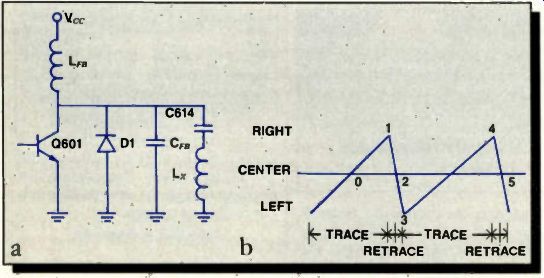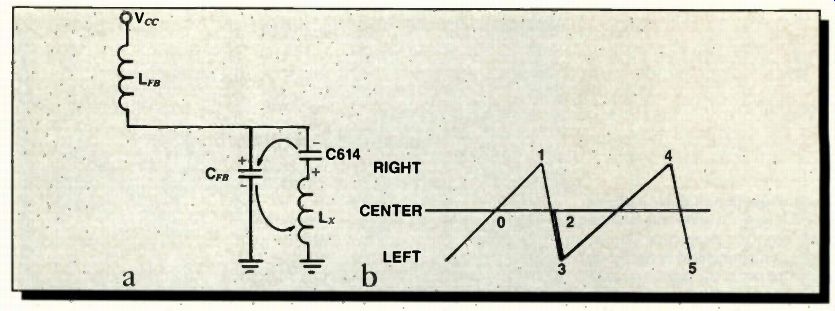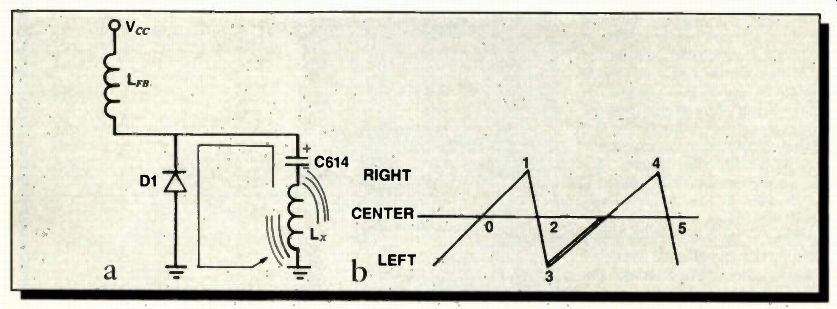by Robert Arso [Arso is chairman of the electronic technology dept. at Bismarck State College.]

Figure 1. A simplified schematic of the horizontal output circuit is shown
in Figure 1A. Figure 1B is a representation of the location of the electron
beam on the screen as a function of the horizontal deflection signal. When
the horizontal signal is above the horizontal axis, the beam spot will be
to the right side of the screen. The lower vertical axis represents the left
side of the screen. The horizontal axis represents time. A movement of the
beam from left (lower) to right (upper) is the trace time. When the beam moves
from right (upper) to left (lower), retrace occurs.

Figure 2. Figure 2A shows the magnetic field of two series aiding coils.
The electron beam is represented by the dot and is traveling out of the paper
toward the reader. The arrow heads on the coils indicate the direction of
electron flow in the wire. This diagram represents like fields, which repel
each other. As a result of the interaction of these fields, the electron beam
is deflected to the right. In Figure 2B, the current is reversed in the coils,
and an opposite action can be observed. The beam is deflected to the left.
The horizontal output circuit some times can seem very complicated, but it can be simplified. In this article, we'll discuss the Sears model 564. 50470350/ 351 TV, Sams photo-fact 2281-2. How ever, the explanation can be applied to any transistorized horizontal output circuit.
A simplified schematic is shown in Figure 1A. C fb is the parallel combination of C611, C612 and C613. L„ is the horizontal deflection yoke between terminals WD2 and WD6. DI is the internal damper diode of Q602. L fl, is the primary winding of the flyback transformer between terminals 1 and 6 of 1'602. V,' is basically the same as circuit trace number 2.
Figure 1B is a representation of the location of the electron beam on the screen as a function of the horizontal deflection signal. When the horizontal signal is above the horizontal axis, the beam spot will be to the right side of the screen. The lower vertical axis represents the left side of the screen.
The horizontal axis represents time. A movement of the beam from left (lower) to right (upper) is the trace time.
When the beam moves from right (up per) to left (lower), retrace occurs. The trace time is approximately 53.3µs. The retrace time along with blanking takes approximately 10.2µs.
The basics Let's look at some basic facts about capacitors and inductors:
• The total capacitance of capacitors placed in series is equal to a value that is smaller than the smallest capacitor.
• An inductor will develop a magnetic field around itself as current flows through it. This field tends to oppose the current that produces it. When the source current stops, the magnetic field collapses into the inductor, producing a current flow in the same direction the source flow was in
• An electron beam will be deflected perpendicular (broadside) to a magnetic field. Figure 2A shows the magnetic field of two series aiding coils. The electron beam is represented by the dot and is traveling out of the paper toward the reader. The arrow heads on the coils indicate the direction of electron flow in the wire. All magnetic fields are determined by the left-hand rule.
Notice that the magnetic field is or biting in a clockwise direction around the electron beam. With the magnetic field of the electron beam traveling in a clockwise direction and the magnetic field of the coils traveling in an upward direction, an attraction in fields is felt on the right side of the diagram because the fields are opposite to each other. The fields are all traveling in the same direction on the left side of the diagram. This diagram represents like fields, which re pel each other. As a result of the inter action of these fields, the electron beam is deflected to the right. In Figure 2B, the current is reversed in the coils, and an opposite action can be observed. The beam is deflected to the left.

Figure 3. In Figure 3A, C614 has just been fully charged through D1 by the
collapsing field of L, and the charge current has stopped. With no current
flowing through the yoke, the electron beam will be positioned at the center
of the screen (point 0 in Figure 3B).

Figure 4. In Figure 4A, 0601 is turned on by the horizontal oscillator signal
for approximately 25/is, allowing C614 to discharge through L. The magnetic
field developed around L causes the beam to travel to the right side of the
screen (points 0 to 1 in Figure 4B). With 0601 on, C,,, is bypassed and D1
is reverse-biased.

Figure 6. In Figure 6A, the magnetic field around L, is reduced to zero once
C614 and Cfb are charged. C614 and start to discharge through L,. In Figure
6B, the magnetic field produced by this reverse current allows the electron
beam to travel from the center of the screen to the left side. This is still
the retrace mode.

Figure 7. In Figure 7A, C614 and Cm are discharged, which causes the magnetic
field around L. to collapse and cause a current to forward bias D1. This current
will also charge C614 in the opposite direction. This is the beginning of
the trace mode, which allows the beam to travel from the left side of the
screen to the center of the screen, as shown in Figure 7B.

Figure 5. In Figure 5A, 0601 turns off after 25 us and C614 continues to
discharge, but through C / h. Once C614 discharges, the magnetic field about
L, collapses and causes a current to flow in the same direction as the discharge
current. This current causes C614 and C,,, to charge as shown in Figure 5B.
D1 is still reverse-biased. The total capacitance in series with L, decreases
and raises the resonant frequency of the circuit, causing the beam to travel
at a faster rate. The electron beam is extinguished as it travels at a rapid
retrace speed from the right side of the screen to the center. This is the
retrace mode (points 1 to 2 in Figure 5C).
• A resonant circuit is formed by connecting a capacitor and an inductor together. The resonant frequency occurs when X. equals X,. The resonant frequency of the circuit will increase if either the capacitance or the inductance decreases.
Horizontal deflection In our discussion of the systematic chain of events that take place during horizontal deflection, let's start by assuming that C614 has just been fully charged through D1 by the collapsing field of L, and that the charge current has stopped. (See Figure 3A.) With no current flowing through the yoke, the electron beam will be positioned at the center of the screen (point 0 in Figure 3B). Q601 is now turned on by the horizontal oscillator signal for approximately 25µs, allowing C614 to discharge through L. (See Figure 4A.) The magnetic field developed around L, causes the beam to travel to the right side of the screen (points 0 to 1 in Figure 4B). Note that with Q601 on, Co is bypassed and D1 is reverse-biased. For clarity, all electrically inactive components will not be shown in the diagrams.
After 25s, Q601 turns off and C614 continues to discharge, but now through Co. (See Figure 5A.) Once C614 discharges, the magnetic field about L. collapses and causes a current to flow in the same direction as the discharge current. This current now causes C614 and Co to charge as shown in Figure 5B. D1 is still reverse-biased. The total capacitance in series with L, now decreases and raises the resonant frequency of the circuit, causing the beam to travel at a faster rate. The electron beam is extinguished as it travels at a rapid retrace speed from the right side of the screen to the center. This is the retrace mode (points 1 to 2 in Figure 5C). Once C614 and Co are charged, the magnetic field around L. is reduced to zero. C614 and C fb now start to discharge through L. (See Figure 6A.) The magnetic field that is now produced by this reverse current allows the electron beam to travel from the center of the screen to the left side. This is still the retrace mode. (See Figure 6B.) After C614 and C fb are discharged, the magnetic field around L will collapse and cause a current to forward-bias D1. This current will also charge C614 in the opposite direction. (See Figure 7A.) This is the beginning of the trace mode, which allows the beam to travel from the left side of the screen to the center of the screen. (See Figure 7B.) The sequence repeats itself at step one.